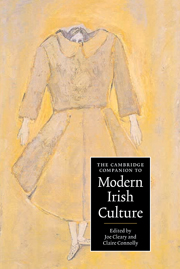Book contents
- Frontmatter
- 1 Introduction: Ireland and modernity
- Part I Cultural politics
- Part II Cultural practices and cultural forms
- 9 Modernism and the Irish revival
- 10 Poetry in Ireland
- 11 Irish sport
- 12 Projecting the nation: cinema and culture
- 13 Folk culture
- 14 Irish prose fiction
- 15 Irish music
- 16 Modern architecture and national identity in Ireland
- 17 The visual arts in Ireland
- 18 Irish theatre
- Index
14 - Irish prose fiction
from Part II - Cultural practices and cultural forms
Published online by Cambridge University Press: 28 May 2006
- Frontmatter
- 1 Introduction: Ireland and modernity
- Part I Cultural politics
- Part II Cultural practices and cultural forms
- 9 Modernism and the Irish revival
- 10 Poetry in Ireland
- 11 Irish sport
- 12 Projecting the nation: cinema and culture
- 13 Folk culture
- 14 Irish prose fiction
- 15 Irish music
- 16 Modern architecture and national identity in Ireland
- 17 The visual arts in Ireland
- 18 Irish theatre
- Index
Summary
Introduction
The novel, the dominant narrative form in the English-speaking world for the period treated in this volume, is not an indigenous Irish form. When novels did come to be written in and about Ireland (from the late eighteenth century), English was the language of expression and the influence of Irish-language narratives on these new productions was not obvious. Nonetheless, writers in English from the time of Maria Edgeworth's Castle Rackrent (1800) have been at least intermittently and selectively responsive to Irish-language materials, particularly the largely oral story-telling tradition. When an important Irish-language tradition of prose fiction did emerge, at the beginning of the twentieth century, it drew energy from both the revival of indigenous forms and English language influences. Thus, it is no longer possible to insist with some of the older cultural nationalists that prose fiction in Irish owes nothing to Irish prose fiction in English. Much scholarly work remains to be done, however, in investigating the two bodies of writing and in establishing points of contact. This chapter treats the two traditions of novel writing in separate sections,but aims to offer readers a rich sense of the Irish novel as it developed across a range of voices, forms and languages.
Prose fiction in Irish
The history of prose literature in Irish since 1800 inevitably reflects the shifting state of the Irish language itself during that period, from its cataclysmic decline in the nineteenth century and its revival at the end of that century and on to its continuing survival today.
- Type
- Chapter
- Information
- The Cambridge Companion to Modern Irish Culture , pp. 245 - 266Publisher: Cambridge University PressPrint publication year: 2005
- 1
- Cited by



